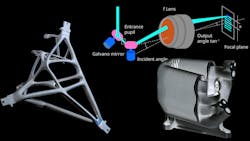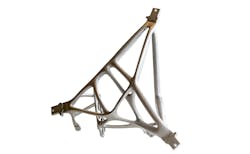Five Considerations for Building a Metal AM Business Case
Additive manufacturing (AM) is becoming a core element of production workflows for manufacturers looking to improve efficiencies, better manage their supply chains and maintain competitive advantage. In a recent EY study, “3D Printing: Hype or Game Changer,” it is confirmed the adoption of additive is ramping with nearly 75% of companies either already embracing the technology or considering its integration into their manufacturing workflow. However, the introduction of these technologies into existing business models and workflows can be challenging for those who are new to AM. Drawing on the know-how of AM experts can help companies plan for and execute successful implementation.
The Business Case for Metal AM
Metal AM is a design-driven manufacturing process that uses high-powered lasers to selectively weld powdered material where prescribed and leave it to be evacuated where unwanted. Companies typically invest in metal AM to take advantage of the benefits unlocked by the nearly unlimited design flexibility of a digital workflow.
Metal AM also enables creation of parts that would be nearly impossible to produce in any other way, featuring custom exterior or interior geometries that lower weight (which translates to cost reduction in production and implementation, or both) or improve functionality (which can also have significant economic ramifications). Additionally, metal AM makes it possible to consolidate multiple parts into a single design and replace complex assemblies of components, which limits associated labor costs and contributes to enhanced structural integrity through the elimination of weak joining points.
Beyond the economic values already listed, metal AM opens the door to more agile manufacturing, mass customization and supply chain consolidation. Increasing productivity, reducing inventory and accelerating time-to-market become tangible and strategic opportunities with the correct metal AM solution.
Five Factors that Impact Metal AM Quality & Repeatability
One of the key components at the heart of a metal digital manufacturing solution is the metal 3D printer that transforms metal powder materials into final metal parts. Every piece of the metal 3D printing process has an impact on the outcome. How these pieces interact and are managed influences overall AM quality and repeatability.
There are several metal AM printers available that use a laser-based process to deliver parts, including laser powder bed fusion (LPBF), direct metal printing (DMP), selective laser melting (SLM) and direct metal laser sintering (DMLS). The trick is finding a system that enables consistent quality and repeatability. In selecting the appropriate system for an application, it is imperative the following five factors are considered.
1. Premium Laser Control
The chain from the laser source to the melting of powder particles is at the core of every metal 3D printer. Any concession made in this chain can degrade the quality and accuracy of the additive manufacturing process, resulting in a negative impact on parts produced.
As mentioned above, metal AM is an optical process. Therefore, the laser source and the entire optical chain must be accurate and robust. The laser source must emit a high-intensity laser beam to feed sufficient energy into the optical chain. An optimal laser beam of 50 or 65 μm will ensure proper melting and high accuracy AM. The quality achieved by such a system typically translates into a 150 μm achievable wall thickness and standard deviations as low as 25 μm.
2. Qualitative Powder Use & Process Emissions Evacuation
Process emissions resulting from improper argon flow management are detrimental to quality in metal AM. Likewise, the use of metal alloy powder that is suboptimal in quality or purity—which is inadequately matched with printing parameters—will also diminish the printing process. It is advised to use ready-to-run metal alloy powders, which are specifically developed and supplied for metal AM purposes.
Operating metal AM printers with optimized, tuned powder types contributes to higher-quality part outcomes and an increased first-time-right experience. The print file, which tells the 3D printer what and how to print, is based on extensively developed algorithms for each material. The quality of these algorithms heavily influences the final part quality and radically reduces the time customers need to achieve the targeted properties for any specific part.
Because metal AM is essentially a welding process using powder, it is important that argon flow in the print chamber be properly managed. If argon flow is mismanaged, emitted particles are at risk of absorbing laser energy. To avoid quality issues, a robust and highly controllable argon flow system is necessary.
3. Inert Atmosphere with Steady, Ultra-Low Oxygen Level
An inert gas environment inside the 3D printer plays an important role in metal AM quality. More specifically, the AM process will be affected by oxygen and moisture content. Air trapped between powder particles, even in low quantities, is likely to have an impact and introduce metal oxidation, which leads to weaker, more brittle materials.
Applying a vacuum is an effective approach to removing air. A vacuum is achieved from executing multiple inerting cycles to obtain an ultra-low oxygen atmosphere in the 3D printer’s build area and material storage space. A proven process used in critical welding applications, the vacuum concept removes air from the build chamber and actively extracts air and humidity from between the powder particles.
Inerting processes that use and print inside a vacuum chamber consistently achieve <25 ppm of O2. Other inerting processes achieve between 500 and 1,000 ppm. As a result of extremely low oxygen pickup, such a printer enables considerable savings on raw materials due to the full reusability of the recycled metal powder. Beyond the cost savings on argon, the savings enabled by powder reusability are extremely valuable over time, allowing users to make full use of materials at full quality.4. Real-Time Process Monitoring & Automated Quality Analysis
Quality analysis of the final part is key in serial part production, and many companies looking into the technology underestimate the cost and time factor currently required. Metal 3D printers that capture visible light images of the powder bed both before and after scanning—as well as visible light images of the melt pool—are ideally suited for process monitoring and non-destructive quality control of the parts being produced.
Additionally, to support traceability, look for a metal 3D printer that automatically records all graphical data, including backup to a server. Access to this wealth of data supports informed decision-making. Established process traceability and related documentation are proven to be useful and are mandatory within highly regulated industries such as aerospace and healthcare.
While most available systems on the market gather tremendous amounts of data (gigabyte upon gigabyte) and offer some kind of representation, this approach is rarely as helpful as it seems because it requires the intentional allocation of time and attention to sort through and analyze it. To combat this shortcoming, some manufacturers offer graphs of certain quality parameters. A problem arises when defining these quality parameters, as they do not sync to industry quality controls in terms of factors that define the mechanical integrity of the part, such as porosity, location of voids, and surface defects. Perhaps even more significantly, many software programs provide no guarantee of the accuracy of the data.
Look for a solution that includes tools that enable users to see and analyze defects in the correct size and at the correct location with high accuracy for defect detection (99.9% for pore detection of pores 200 um or larger). This can help users reduce or eliminate the number of bad parts going through downstream quality inspection steps.
5. Software that Spans the Entire AM Workflow
Achieving successful prints is the key objective of the AM workflow. Getting from design to a repeatable manufacturing process with optimized cost structure is key and requires a software solution that integrates the entire workflow of preparation, optimization and manufacturing of 3D CAD models. There are many software solutions available that address a portion of these steps, but only a select few cover the entire workflow.
An integrated all-in-one solution will allow users to easily move from one stage to another without file format conversion, thus saving a lengthy, error-prone iterative process. Other key features that will facilitate the 3D printing process include:
- Native data import, eliminating the need to convert to STL, maintaining design integrity and saving time on fixing error-prone data format conversion issues
- Structure optimization capabilities that enable users to save on weight, material and printing time
- Integrated build simulation within the design environment minimizes try-outs, shortens lead time and cuts production cost
- Optimized slicing and hatching ensure repeatable, high-quality prints while minimizing print time
- Programing of post-processing operations like machining and drilling tools to remove supports; machine high-quality surface areas; and drill, tap or ream holes. Additionally, applying smart machining templates enables smooth integration of additive and subtractive processes for best final part results and lowest achievable cost per part.
Integrated Solutions Fuel Innovation
Metal AM has become an important technology for end use production applications—especially for the aerospace and healthcare industries. This is due in large part because of its benefits: part cost reduction, increasing efficiency of designs, light weighting of parts, assembly consolidation and the ability to design and produce unique parts that would not be possible with traditional manufacturing technologies.
The most successful digital manufacturing solutions complete metal 3D printing workflows tailored to a specific application—optimized for scalability, high throughput and low total cost of operation—to produce repeatable, high-quality parts from the most challenging alloys. As adoption of metal AM increases, companies will transform how they create new, improved products while gaining efficiencies that place them well ahead of their competitors.
Mark Cook started his career as a design engineer developing new products for the aerospace, consumer, industrial and medical markets. In 2005, Cook joined Z Corporation to develop full-color 3D printers used for rapid concept modeling, and then joined 3D Systems in 2012 when Z Corporation was acquired. He earned a B.S. in mechanical engineering at Northeastern University and an MBA from the D’Amore-McKim School of Business at Northeastern University.
About the Author
Mark Cook
Design Engineer, 3D Systems
Mark Cook started his career as a design engineer developing new products for the aerospace, consumer, industrial and medical markets. In 2005, Cook joined Z Corporation to develop full-color 3D printers used for rapid concept modeling, and then joined 3D Systems in 2012 when Z Corporation was acquired. He earned a B.S. in mechanical engineering at Northeastern University and an MBA from the D’Amore-McKim School of Business at Northeastern University.



